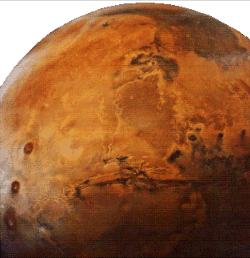Mariner 9
 Mariner 4, 6, 7, were flyby missions that could only photograph small regions
of the Martian surface. They saw portions of the surface that suggested Mars
was drab and cratered like the Moon, and geologically dead. This was changed
profoundly by the orbiter Mariner 9, which went into orbit around Mars in late
1971. When it arrived the entire Martian surface was engulfed in a dust storm
that left almost no surface features visible.
Mariner 4, 6, 7, were flyby missions that could only photograph small regions
of the Martian surface. They saw portions of the surface that suggested Mars
was drab and cratered like the Moon, and geologically dead. This was changed
profoundly by the orbiter Mariner 9, which went into orbit around Mars in late
1971. When it arrived the entire Martian surface was engulfed in a dust storm
that left almost no surface features visible.
When the dust storm finally
subsided in early 1972, Mariner 9 discovered that we had been badly misled by
the earlier flyby missions that had seen only small (in retrospect,
unrepresentative) portions of the surface.
Mariner 9 found evidence for a planet having many
interesting geological features:
- Meteor craters and volcanic plains
(the largest crater is Hellas, which is 2000 km across).
- Huge volcanic cones (the three round
features at the left of the
adjacent image
are volcanic cones).
- Gorges larger than the Grand Canyon here on Earth (the feature in the
center of the adjacent image is a canyon system, Valles Marineris,
that extends over a region the width of the United States).
- Vast sedimentary deposits in the Polar regions.
- Valleys that looked as if they could be water-formed (but these don't
coincide with the "canals" that people erroneously thought they saw from Earth in
earlier times).
No spacecraft in the history of space exploration has more profoundly changed
our view of a planet than Mariner 9.
 Mariner 4, 6, 7, were flyby missions that could only photograph small regions
of the Martian surface. They saw portions of the surface that suggested Mars
was drab and cratered like the Moon, and geologically dead. This was changed
profoundly by the orbiter Mariner 9, which went into orbit around Mars in late
1971. When it arrived the entire Martian surface was engulfed in a dust storm
that left almost no surface features visible.
Mariner 4, 6, 7, were flyby missions that could only photograph small regions
of the Martian surface. They saw portions of the surface that suggested Mars
was drab and cratered like the Moon, and geologically dead. This was changed
profoundly by the orbiter Mariner 9, which went into orbit around Mars in late
1971. When it arrived the entire Martian surface was engulfed in a dust storm
that left almost no surface features visible.